


Overview
99% of hand written numbers are converted to data correctly. Free hand text sentences are correctly converted over 85% of the time. Codes and abbreviations can be decoded using a lexicon or a complement to the usual English dictionary. Equipment or part numbers are always a challenge! There are at least 2 reasons: a) there is never enough space on the paper for an unusually long part no, and b) they often are a mix of alpha & numeric. Without context, there is a 50% chance of converting the letter O to the number 0, or I to 1 etc.
Consequently, it takes longer to review and correct part number fields. This information is often required to account for stock, order or cost of materials used in services.
There are 2 theoretical elegant solutions for this problem:
- The ability to input the part no using the mobile phone keyboard before the mobile phone routers sends the digital pen data to the server
- Use a digital catalogue.
If the parts or the numbers to use change quite often, solution 1 is preferred. The router can interrogate the server and get the most recent list of relevant parts to choose from. Otherwise, the digital catalogue is the most comfortable and efficient solution.
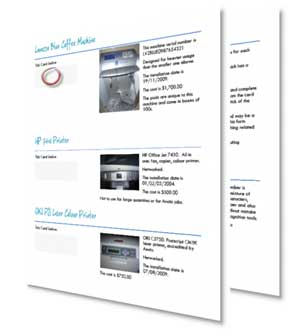 What is a digital pen and paper catalogue?
What is a digital pen and paper catalogue?
In short, it is a normal paper catalogue describing each part, with images if necessary, and any other useful information. Next to each part described, a unique Anoto dot pattern area is inserted.
The Anoto enabled functionality is conceptually similar to a barcode in this instance. Although the digital pen could read certain barcode types (of well chosen dimensions), practically it is not always easy: the barcode needs to be flat, the pen user has to draw a nice steady line at the right speed over the code and under appropriate light. Experience shows that a user often fails to read a barcode with digital pen and gets frustrated at retrying several times.
How to get started
Any service form can be changed to work with a digital catalogue. The first step is to supply a PDF file of the catalogue with enough space for the card to be inserted, and a spreadsheet file with the part no in the same order.
The cost of building the catalogue is related to the number of cards and pages to create as well as modifying the existing service form to incorporate the read part no. section and the new send pidget.
- PDF of catalogue of parts
- Spreadsheet with part no in order
- Sign off modified Service form layout
Please email at info@crendalcomputing.com.au to enquire about the cost of the service or if you wish to learn more about this digital pen solution
This template is designed for mobile service technicians. It is a great way to start a digital and paper pen application within days.
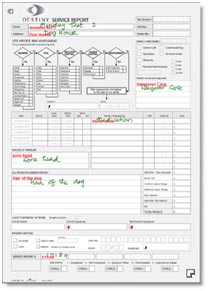
The digital pens are quite popular amongst mobile services technicians and engineers. With over 4 years experiences we are offering a generic form for service repair or break and fix. It is a great way to start, for a small company or for testing the concepts at a small scale.
The Generic Service Form has some OH&S components, description of the service and parts used, with the possibility to use it as a tax invoice. The data captured can be viewed and edited through the powerful Silhouette platform, and the data is downloaded manually from the web.
The Generic Form is a shared service to keep the cost as low as possible. Further customisations are available or upgrade to a fully customised form. Additional charges would apply. There are 2 layouts available, one with multiple send capabilities and one without. The multiple send feature allows the technician to use the same page several times, in case the job is put on hold.
Please email at info@crendalcomputing.com.au to enquire about the cost of the service or if you wish to learn more about this digital pen solution.
Also called the scratch pad, can complement your existing service forms or be used as a standalone notebook. It sends emails of a PDF of the page to a list of recipient which is customised for each pen user. A form reference field can be used to associate this form with others.
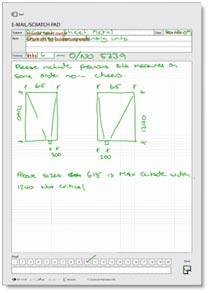
This scratch pad is often used in complement of a service form, when there is quite a lot to write or draw. It is a convenient pad to use for quickly sharing some information, adding instructions or more detailed explanations related to a service call.
Each pad has a series of 20 email boxes which can be configured for each pen user. A PDF rendering the page and its writing is sent to the configured addresses.
The form is also managed by the powerful Silhouette viewer and can be associated to another paper form if using a common reference field.
Please email at info@crendalcomputing.com.au to enquire about the cost of the service or if you wish to learn more about this digital pen solution.
A group of forms designed for the periodic testings of fire protection equipments. Our customers maintain the templates according to new regulations. Each test returns a pass or fail and can match a maintenance schedule set up on our server or on the customer's server. A specific service form for the industry is also offered.
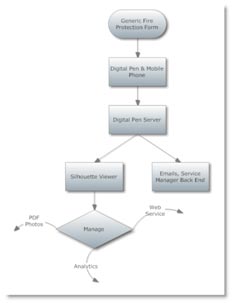
Testing and reporting on fire protection equipments is often done using regulated procedures and paper forms. With the experience of our customers, we have developed and continue developing a number of Generic Fire Protection Forms, which can be used with each customer's logo.
There are 2 types of forms: a form designed for a specific equipment for instance a Sound System, and a form which could be used to test multiple equipment.
The tests are performed as part of a preventive routine maintenance, and the tasks of the routine maintenance follow a specific time cycle. The main objectives of this solution are:
- To follow regulations and log each visit
- To report the tests results and act promptly when necessary.
The list of forms is growing regularly, please email to info@crendalcomputing.com.au to get the latest update. They are grouped as follows:
- Inspection Cycle = Weekly / Monthly, or 6 Monthly / Yearly etc...
- Equipment Type = { Sprinklers Hydrants & Hose reel Pumps, Sounds & Intercom, Fire Detection Systems, FIP, EWIS, etc... }
- Service Log Book for Break and Fix
- Asset Tests and Run sheet
- Asset Registration Sheet
The data collected by the digital pen is turned into XML format which can be exchanged with service management software of choice. The Silhouette Viewer can be used to retrieve any document, search for failed tests and the Silhouette Bi Components presents statistics per site, equipment or technicians.
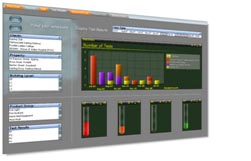
The Generic Fire Protection Forms software shares some of the features available in the more general Routine Maintenance Management solution (RMM).
Click here to read more about RMM.
It is also possible to integrate the OSEC system (On site Equipment Cards) with the Asset Tests and Run Sheet.
Click here to read more about OSEC.
OSEC is a concept that can be integrated to any forms. The small card of unique dot pattern is registered on line and carries with it the necessary set of information required for various tasks. Tick it and you capture the time, the pen user, and all the data registered such as equipment serial number and site location.
On Site Equipment Cards (OSEC) were designed to fulfil two objectives:
- To be used like barcodes and stickers on site, having the unique dot pattern registered to equipments or sites.
- To provide a proof of on site visit by a pen user. The dot pattern cannot be copied, and one pen stroke records the time and date of visit of the pen user.
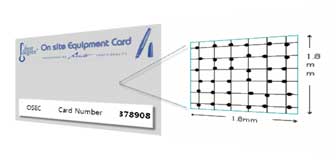
OSEC is very useful when a technician needs to write an asset number of a part number on paper. Often these numbers are long, a mixed of alpha and numeric characters, and data input is always difficult if not inaccurate. With a sticker or a catalogue of cards, it is easier to use than barcodes: technicians just tick the card and continue writing on their service form.
OSEC are used in equipment testing or routine maintenance applications. But they can also be used as a timesheet for instance: a pen user signs in or out on her/his personal OSEC or the other way around, with her/his pen the user signs on or off using the building or site unique card.
So, how to get started with OSEC?
- Choose the layout and size of the cards, we offer 3 sizes: 55 or 9 cards for an A4 plastic page, or an individual tag A4 / 64 which can be inserted in a catalogue PDF.
- Have a database system which registers all information associated to each card. One can use our web based asset registry system.
- Have a service form with a send box compatible with OSEC.
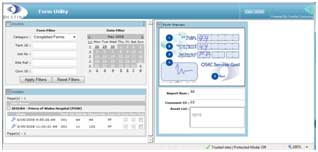
Please email us at info@crendalcomputing.com.au
CCi RMM product suite, which is designed to work with Digital Pen and Paper incorporating the Anoto dot pattern functionality.
The product is the total solution, from database server structure and data loads to user digital pen strokes processing and reporting tools.
The Task-Asset template is designed for a preventative maintenance system where a list of tasks to perform is printed on an A4 page for one asset or one asset group. You may have hundreds of pages like the ones illustrated below:
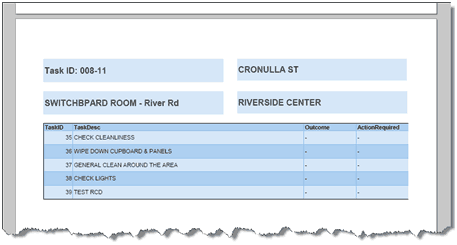
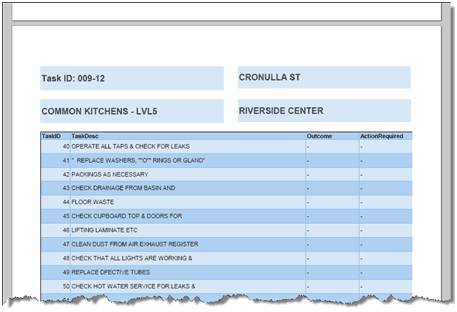
How does it work ?
A template is designed to fit on all pages of the routine maintenance plan reports:
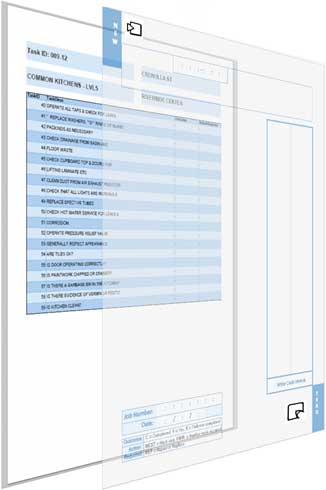
The engineer writes with the digital pen the task id or the job number, the outcome or action required codes on the template, and ticks the magic box to send the pen strokes to the digital pen server.
The server will look at the task id or the job number written and will identify automatically the rest of the information.
The Job number is the Task ID plus the planned date.
The system can work with OSEC (On Site Equipment Cards) and in that case, the routine plan does not have to have the Equipment details or location on the paper
Components
CCi RMM has a Silhouette form viewer to edit the pen strokes processed. It also offers optional components and can integrate with any other server using web services. The three main components are 1) reporting the routine maintenance results and 2) administering the data used by the system, 3) Pushing the data and PDF images using web services to an external server.
Printing and Reporting
CCi RMM has a reporting tool to analyse the outcome of preventive maintenance. The analytical tool produces statistics on the activity and a report of the action required. The tasks which failed to complete successfully can be picked up and new job numbers issued in the maintenance module for these tasks only.
The software used is a state of the art Business Intelligence system, which we licensed on our server. The standard interface is a zero foot print web browser, but more complex requirements could use an IE plug-in.
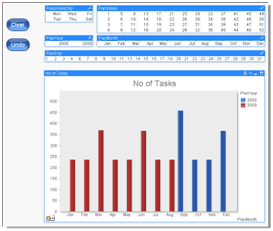
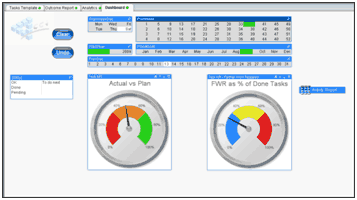
Please email us at info@crendalcomputing.com.au
JPM is a web based application which assist a central office to manage the allocation of tasks or jobs to resources or a mobile users.
JPM does not determine which task should be allocated to which resource. It enables the process, and provides a monitoring function to the central office in charge of the allocation.
JPM pushes a job request to a resource, field engineer or technician on site, and displays feedback or job completion data. It can be integrated to Destiny digital pen and paper applications developed by Crendal Computing international (CCi).
How does it work?
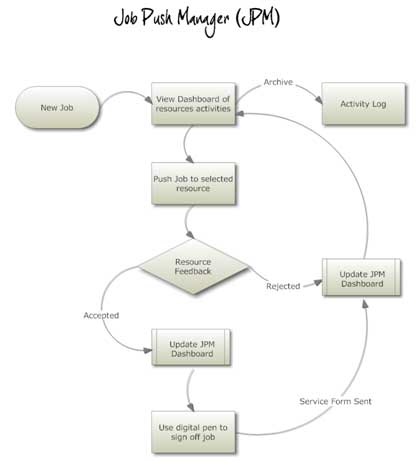
JPM Dashboard

The dashboard as illustrated above shows all information about the current list of job, with a colour for each status: pending, offered, accepted, rejected, completed. The dashboard has many search and filter functions, as well as a data import facility.
New tasks are added manually or existing entries can be modified directly from the JPM Dashboard.
Offering a job
When offering a Job to a resource, the system sends an SMS to the mobile phone registered for the selected resource or technician. The SMS is a link to a web page, which displays all the information as well as a Accept or Reject button.
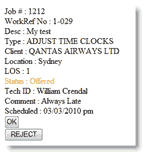
If the job is accepted, the dashboard would show the job as Green. When the digital paper service form related to this job is received, the status of the job changes to Blue or completed where a PDF of the form can be downloaded.
JPM Data Entry
The list of resources or field technicians or engineers is maintained through JPM. The data is added, removed, edited manually or loaded from a CSV file.
Other methods of inputting data are also available; we can offer a web services API with various methods to push or get data from the system.
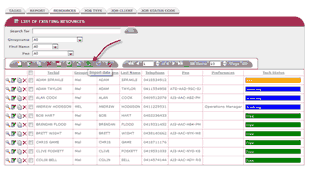
To enquire about this product, email us at info@crendalcomputing.com.au
This note template is combining the power of a digital pen and a Microsoft Word add-in called iSiWord developed by EasyTechno. iSiWord Pad is programmed to send an email of a PDF and a doc file which contains iSiWord instructions. When opening the doc file, iSiWord expands it and using the appropriate word template it creates a fully formatted word document.
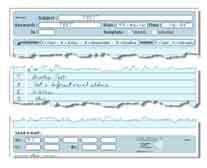
The iSiWord pad has 2 templates by default: a memo and a meeting minutes. Each iSiWord template can be customised for each company.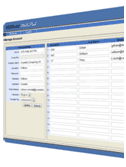
For each template, there are a few keywords which are used to format the document: T for Topics, A for Actions etc.
The email recipients are set online, using the iSiWordPad web page. The system is using 3 letters shortcut to recognise the email addresses associated to each pen user.
iSiWord Pad Collate
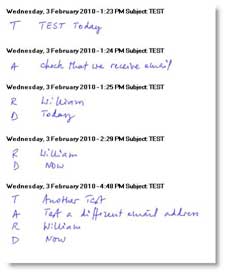
This module to iSiWord pad application is a search and collate tools for notes already received and processed by the digital pen server. It requires a license of a powerful Bi tool running on a web server, and enables a user to search for topics and subject over a period of time.
The collate function cut the hand written strokes of each existing page and assemble them together. There are 3 options: collate by Topic only, Subject only or Subject and Topic.
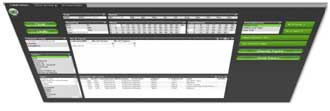
To enquire about this product, email us at info@crendalcomputing.com.au
With Print4Pen, you can print you own document on your local postscript printer and manage it with the powerful Silhouette viewer. This application is great for signing contracts or sharing documents.
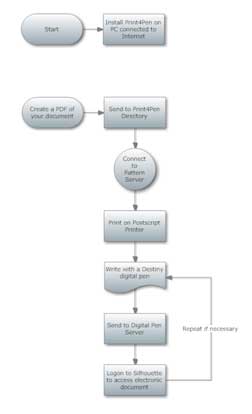
Print4Pen is a software licensed to run on a desktop or a laptop computer which has access to a postscript laser printer. If you can turn a document to a PDF, and you have a Postscript laser printer handy, then you can use your Destiny digital pen with Print4Pen.
Print4Pen accesses our digital pen server over the web and requests a dot pattern license. It prints the document with a unique layer of Anoto dots for each page, ready to be used with Destiny Wireless Australia digital pen services.
Write on the paper, tick the 'send' box or dock the pen to a PC and within seconds, see the document in the Silhouette Viewer. One can write as many times as necessary on a document, as the pattern licensed is unique and permanent until archived. The viewer will display all the combined pen strokes, or create a PDF of a page or the entire document (including the pages with not writing on it).
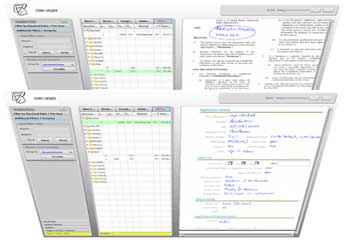
A secure login mechanism allows each user to see only documents written with a specific group of pens or only documents printed with the licensed Print4Pen application or documents that are shared.
Print4Pen is a great product for a company or an individual. Read about TopYacht DP&P Application for an example or email at info@crendalcomputing.com.au to enquire about pricing.
TopYacht software is widely used by sailing clubs in Australia to record, calculate and publish the results of yacht racing. Recording on the water, near the finishing line, the sail number and the finishing time of each competitor can be quite difficult. One could get sea sick quickly and the recording method used must be easy to use and fast. With the team of TopYacht software, we have designed 3 forms which can be used by sailing clubs having purchased a Destiny digital pen.
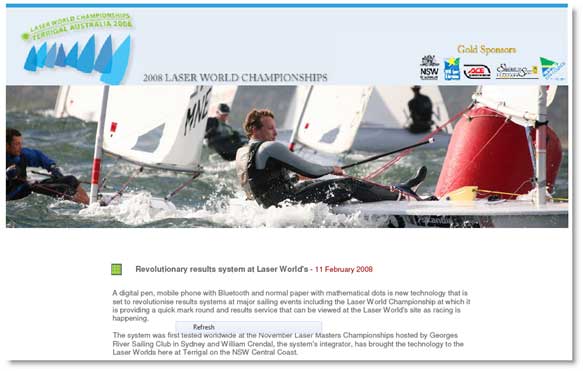
The first one was designed for recording the results of the world laser championship of February 2008, which was in the open sea near Terrigal New South Wales. The results were captured on the water and were almost immediately available to the race head quarter, which could compile provisory results before the competitors were back from the race courses.
It gave plenty of time to competitors, coaches and media persons to work on the same day. Each day results were publish early enough to be in the morning newspaper.
Strong off this successful experience, we developed 2 variations of the digital pen and paper form.
The second, designed to use the clock of the digital pen to record the time of a yacht crossing the finishing line. The data is downloaded in a CSV file which can be imported into TopYacht or similar software. This form is mainly used for Ocean racing, where handicaps are counted and the time of arrival of each boat is critical.
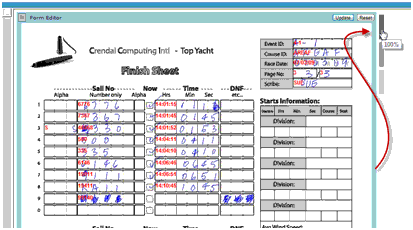
The third form is used every week-end in Australia. It is simpler to use, and captures the hand writing without converting to data. The form was designed with Print4Pen and each club can buy pages when they need.
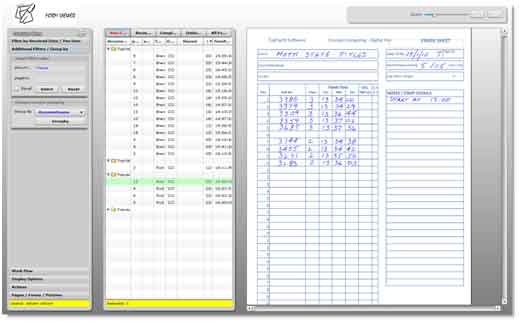
The result sheets are on the web within seconds of the race finishing. A race can be in Sydney harbour and the person processing the results in Melbourne. Despite the low cost of this application, the main advantages are that the recorders do not need a huge training, they rarely get sea sick and the digital pen is fairly robust.
To obtain costing or discuss this application, do not hesitate to call us or email at info@crendalcomputing.com.au



